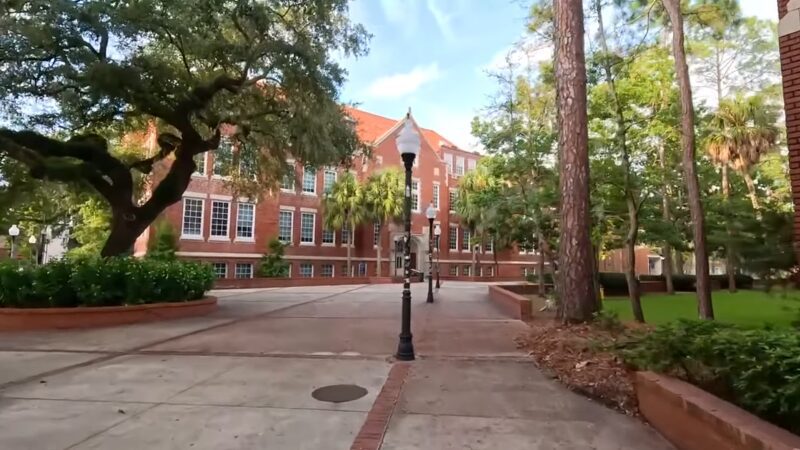Choosing between a public university and a private college is a critical decision for students and their families.
Public universities often have lower tuition fees because they receive state government funding, making them more affordable.
The cost difference is significant. In the 2020-2021 school year, average tuition and fees were nearly $38,000 at private colleges, compared to just under $11,000 at public universities. These savings can allow students to afford additional opportunities, like study abroad programs.
Government subsidies help reduce tuition rates at public universities, especially for in-state students. Even out-of-state tuition at public universities can be more cost-effective than private colleges.
Key Factors

Public universities are typically owned and funded by state governments. This public funding allows them to offer lower tuition rates, particularly for in-state students.
Private universities receive their funding primarily from tuition fees, private donors, and other non-governmental sources. Consequently, they tend to have higher tuition fees compared to public institutions.
Funding Source
- Public Universities: Government subsidies
- Private Universities: Private donors, tuition fees
Tuition Cost
- Public Universities: Lower, especially for in-state students
- Private Universities: Generally higher
Public universities often enroll a larger number of students. This scale can offer more diverse program options and varied social opportunities.
Students at private universities like those with the lowest acceptance rates in the world might experience tighter-knit communities and specialized academic resources, enriching their educational journey.
Private universities tend to have smaller student populations, which can foster a more personalized educational experience.
This setting may also provide closer interaction between students and faculty.
Student Population

- Public Universities: Larger student body
- Private Universities: Smaller, more intimate settings
Scholarships and financial aid packages play a significant role in making private education more accessible. In some cases, these can reduce the cost significantly, rivaling that of public universities.
Financial Aid
- Public Universities: State grants, federal aid
- Private Universities: Institutional scholarships, private grants
Public universities generally offer a wider variety of programs and majors due to their size and funding structure.
Private universities might specialize in certain fields, providing focused resources and facilities.
Program Variety
- Public Universities: Broad range of programs
- Private Universities: Specialized fields
Average Tuition Rates

Public universities often offer significantly lower tuition rates than private universities. This difference is due to the substantial government funding that public institutions receive.
For example, the average tuition cost for in-state students at public four-year institutions is approximately $10,940 annually, while private institutions charge around $35,000 to $50,000 per year. Out-of-state students at public institutions may pay closer to $28,240 annually, still often less than the tuition at private universities.
These lower costs make public universities more accessible to a broader demographic, particularly for students from middle- and low-income families.
Financial Aid and Scholarships
In addition to lower tuition rates, public universities frequently offer robust financial aid packages. They benefit from federal and state grants, which are predominantly available to students attending these institutions.
Private universities also provide financial support, but it often comes from private endowments and donations.
Public institutions avail government-funded scholarships and grants, making education more affordable for qualified students. Programs like Pell Grants and state-specific scholarships are critical for aiding students at public universities.
Government Subsidies and Their Impact

Government subsidies play a significant role in making public universities more affordable. These subsidies often come in the form of direct funding to the institutions, reducing the financial burden on students.
Public universities typically receive state funding, which covers a significant portion of operational costs. This allows them to offer lower tuition fees compared to private universities, which rely heavily on tuition revenue.
For example, state universities can use government funds to offset costs related to faculty salaries, infrastructure maintenance, and research programs. This alleviates the need for high tuition fees, providing more accessible education to a broader community.
Benefits of Government Subsidies
- Lower Tuition: Reduced tuition fees for students.
- Access to Quality Education: More affordable post-secondary education options.
- Economic Diversity: Increased opportunities for students from varying economic backgrounds.
In contrast, private universities do not benefit from the same level of public funding. They often rely on private donations, endowments, and tuition fees, resulting in higher costs for students.
According to the College Board, the average total tuition and fees at private colleges for the 2019-20 school year was $36,880, much higher than public institutions.
Understanding the impact of these subsidies reveals why public universities can maintain lower tuition fees and provide broader access to higher education. This financial support is crucial in enabling students to pursue higher education without bearing the full cost of their studies upfront.
Differences in Endowments
Endowments significantly impact university affordability. Endowments are funds from donations invested to generate income. This income supports various university expenses.
Public universities typically have smaller endowments. For instance, 23% of public four-year institutions have endowments of less than $10 million. These limited funds mean public universities rely more on government funding and tuition fees.
In contrast, private universities often have larger endowments. The median endowment at private nonprofit four-year colleges and universities is roughly $37.1 million. This enables private institutions to spend more per student, supporting scholarships, research, and facilities.
Comparison of Endowments
| Type of Institution | Median Endowment | Annual Expenditure Supported |
|---|---|---|
| Public University | Less than $10 million | Limited support, more reliance on tuition |
| Private Nonprofit University | Roughly $37.1 million | $1,484,000 to $1,855,000 annually |
Alumni Giving and Private Support

Alumni giving plays a significant role in the financial support of both private and public universities. Data indicates that alumni contributions to U.S. colleges and universities rose 6.9%, reaching $12.15 billion in 2018. The tendency of alumni to donate can influence the affordability and resources available at these institutions.
Private universities often receive substantial donations from their alumni. For instance, Harvard University secured $1.42 billion in donations in 2018. Such significant contributions help these institutions offer extensive scholarships, top-tier facilities, and advanced research opportunities. In contrast, public universities like the University of California – Los Angeles received $786.66 million in donations.
Although the donation amounts differ, public universities also benefit significantly from alumni support. The alumni contributions aid in maintaining affordability while improving educational facilities. Public institutions typically experience a steady stream of smaller donations, making their funding more reliant on state allocations but still significantly bolstered by alumni generosity.
| University Type | Top Donation | Amount |
|---|---|---|
| Private | Harvard University | $1.42 billion (2018) |
| Public | UCLA | $786.66 million (2018) |
Operational Efficiencies and Overheads

Public universities often benefit from operational efficiencies, which significantly contribute to their affordability. These institutions frequently have streamlined administrative processes that reduce costs.
For instance, the implementation of systems like Workday HCM can drastically cut transactional time for administrative tasks by up to 93%, as demonstrated by Deloitte’s findings.
A focus on cost efficiency is critical. Public universities may participate in detailed cost analysis studies to differentiate expenses across various types of institutions. Understanding operational costs, as noted in NCBI research, helps these universities allocate resources more effectively and maintain lower tuition fees.
Redesigning administrative operations can lead to substantial improvements. McKinsey & Company advocates for a transformational approach over incremental changes, suggesting that universities aim for a 20% improvement in efficiency. This approach involves rethinking entire administrative structures to reduce overhead.
Public universities also rely on state funding and other public investments, which can offset operational expenditures.
This financial support is critical in maintaining lower tuition rates compared to private institutions that often depend heavily on tuition and private donations.

